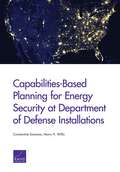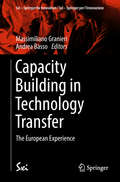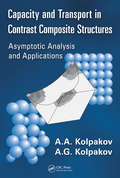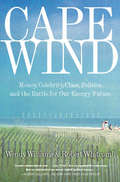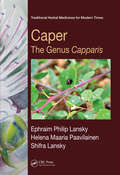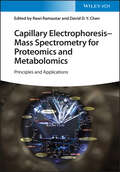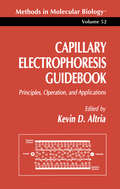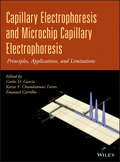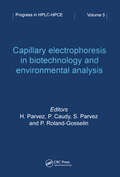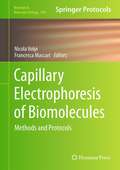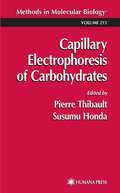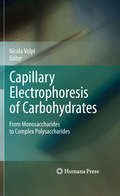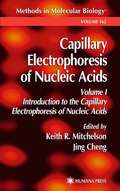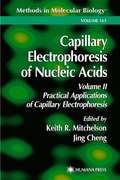- Table View
- List View
Capabilities-Based Planning for Energy Security at Department of Defense Installations
by Henry H. Willis Constantine SamarasDepartment of Defense (DoD) installations rely on the commercial electricity grid for 99 percent of their electricity needs, but the U. S. electricity grid is vulnerable to disruption from natural hazards and actor-induced outages, such as physical or cyber attacks. Using portfolio analysis methods for assessing capability options, this paper presents a framework to evaluate choices among energy security strategies for DoD installations.
Capability Planning and Analysis to Optimize Air Force Intelligence, Surveillance, and Reconnaissance Investments
by National Research Council Division on Engineering and Physical Sciences Committee on Examination of the Air Force Intelligence, Surveillance, and Reconnaissance (ISR) Capability Planning and Analysis (CPA&A) Process Air Force Studies BoardIntelligence, surveillance, and reconnaissance (ISR) capabilities have expanded situation awareness for U.S. forces, provided for more precise combat effects, and enabled better decision making both during conflicts and in peacetime, and reliance on ISR capabilities is expected to increase in the future. ISR capabilities are critical to 3 of the 12 Service Core Functions of the U.S. Air Force: namely, Global Integrated ISR (GIISR) and the ISR components of Cyberspace Superiority and Space Superiority, and contribute to all others. In response to a request from the Air Force for ISR and the Deputy Assistant Secretary of the Air Force for Science, Technology, and Engineering, the National Research Council formed the Committee on Examination of the Air Force Intelligence, Surveillance, and Reconnaissance (ISR) Capability Planning and Analysis (CP&A) Process. In this report, the committee reviews the current approach to the Air Force corporate planning and programming process for ISR capability generation; examines carious analytical methods, processes, and models for large-scale, complex domains like ISR; and identifies the best practices for the Air Force. In Capability Planning and Analysis to Optimize Air Force Intelligence, Surveillance, and Reconnaissance Investments, the current approach is analyzed and the best practices for the Air Force corporate planning and programming processed for ISR are recommended. This report also recommends improvements and changes to existing analytical tools, methods, roles and responsibilities, and organization and management that would be required to ensure the Air Force corporate planning and programming process for ISR is successful in addressing all Joint, National, and Coalition partner's needs.
Capacity Building for the Planning, Assessment and Systematic Observations of Forests: With Special Reference to Tropical Countries (Environmental Science and Engineering)
by Karan Deo SinghThis book is intended to support the forestry institutions in the tropical countries in the planning, assessment and systematic observation of forests required to fulfill their obligations as laid in international conventions such as the CBD and UNFCCC. Following the Rio Conference, a number of countries, donors and international organizations have implemented capacity-building projects with varying degrees of success. One main reason for the varying success rates seems to lie in the design of technical assistance programs, which have been formulated on the traditional lines of mainly generating forest resources information or transferring technology; whereas Agenda 21 requires fundamental changes in countries' institutions and approaches to planning and implementing the conservation and sustainable development of forests through a process of continuing research and analysis. The book is intended to serve the basic needs of national planning strategies and international and donor support.
Capacity Building in Technology Transfer: The European Experience (SxI - Springer for Innovation / SxI - Springer per l'Innovazione #14)
by Massimiliano Granieri Andrea BassoThis book tells the story of capacity building in Europe with respect to technology transfer offices and organizations (TTOs). The traditional underdevelopment of technology markets in Europe has often been explained in terms of lack of capacity and skills among technology transfer professionals, both as individuals and as part of TTOs. Because of the severe consequences for economic development and industrial growth, this situation has been repeatedly addressed by policy makers, until the European Commission, within the framework of Horizon 2020, decided to initiate a pan-European pilot project on capacity building. This book builds on the experience gained through that project and tries to reconnect it with current scholarly works on technology management by focusing on the new methodology developed. In addition, the authors present a series of case studies that may be used as a benchmark and as examples that will help high-potential TTOs to improve their performance. Both practitioners and researchers will benefit from the holistic perspective of the book, which goes beyond the traditional approach and attempts to reconcile the theory and practice of organizing for technology transfer.
Capacity and Transport in Contrast Composite Structures: Asymptotic Analysis and Applications
by A. A. Kolpakov A. G. KolpakovIs it possible to apply a network model to composites with conical inclusions?How does the energy pass through contrast composites? Devoted to the analysis of transport problems for systems of densely packed, high-contrast composite materials, Capacity and Transport in Contrast Composite Structures: Asymptotic Analysis and Applications an
Cape Wind: Money, Celebrity, Class, Politics, and the Battle for Our Energy Future on Nantucket Sound
by Robert WhitcombWhen Jim Gordon set out to build a wind farm off the coast of Cape Cod, he knew some people might object. <P><P>But there was a lot of merit in creating a privately funded, clean energy source for energy-starved New England, and he felt sure most people would recognize it eventually. Instead, all Hell broke loose. Gordon had unwittingly challenged the privileges of some of America's richest and most politically connected people, and they would fight him tooth and nail, no matter what it cost, and even when it made no sense. Cape Wind is a rollicking tale of democracy in action and plutocracy in the raw as played out among colorful and glamorous characters on one of our country's most historic and renowned pieces of coastline. As steeped in American history and local color as The Prince of Providence; as biting, revealing and fun as Philistines at the Hedgerow, it is also a cautionary tale about how money can hijack democracy while America lags behind the rest of the developed world in adopting clean energy.
Caper: The Genus Capparis (Traditional Herbal Medicines for Modern Times)
by Shifra Lansky Helena Maaria Paavilainen Ephraim Philip LanskyCaper: The Genus Capparis presents a pharmacognostic and ethnopharmacological exploration of the genus Capparis, emphasizing its medicinal potential. There is a long history of safe usage of Capparis parts both in diet and as plant drugs throughout the world, and the details of this usage are summarized in 39 tables covering numerous Capparis speci
Capillary Electrophoresis - Mass Spectrometry (CE-MS): Principles and Applications
by Gerhardus De JongThis monograph offers the reader a complete overview on both principles and applications of CE-MS. Starting with general considerations on detection and hyphenation in CE, also related and more specialized techniques such as chromatographic preconcentration and CIEF-MS are discussed. A special emphasis is put on CE-MS interfaces, which are described in detail. Applications to all relevant substance classes are discussed in distinct chapters, each written by experts in the respective fields. Besides classical applications in proteomics and pharmaceutical chemistry, recent implementations in food science, metabolomics, and forensic analysis are highlighted. An unique source of knowledge for everyone dealing with CE-MS.
Capillary Electrophoresis - Mass Spectrometry for Proteomics and Metabolomics: Principles and Applications
by Rawi RamautarCapillary Electrophoresis—Mass Spectrometry for Proteomics and Metabolomics A powerful and essential resource for researchers with an interest in CE-MS In Capillary Electrophoresis—Mass Spectrometry for Proteomics and Metabolomics: Principles and Applications, a team of distinguished researchers delivers a comprehensive overview of bioanalytical capillary electrophoresis coupled to mass spectrometry (CE-MS). The book explains foundational principles, technology as well the strategies and techniques used in data analysis for metabolic and proteomic studies. It also provides a global overview of recent developments and advances for improving CE-MS sensitivity and reproducibility. An essential handbook for everyone performing metabolomic and proteomic analysis, the information provided here will assist researchers in tapping into the full potential of this technique to answer biological and clinical questions. Readers will also find: A thorough introduction to the principles of capillary electrophoresis, including its fundamentals, CE separation modes, capillary coatings, and the fundamentals of mass spectrometry In-depth examinations of technological developments in capillary electrophoresis, including sample preparation, online preconcentration, detection sensitivity, and metabolic coverage Comprehensive discussions of metabolomic studies, including their biomedical and clinical applications Recent advances in proteomics, including top-down and bottom-up approaches Perfect for analytical and clinical chemists, Capillary Electrophoresis—Mass Spectrometry for Proteomics and Metabolomics: Principles and Applications will also earn a place in the libraries of biochemists, molecular biologists, and other molecular life scientists.
Capillary Electrophoresis Guidebook: Principles, Operation, and Applications (Methods in Molecular Biology #52)
by Kevin D. AltriaCapillary Electrophoresis Guidebook offers both newcomers and experienced research workers hands-on guidance to performing capillary electrophoresis. It provides sufficient practical advice to permit you to develop and optimize your own separations, along with extensive troubleshooting sections to overcome practical difficulties. The book contains operating instructions for standard commercially available instruments and includes guidelines for activities such as changing capillaries, method development, quantitative procedures, optimizing sensitivity, and the validation of methods. Review chapters written by leading experts discuss micellar electrokinetic capillary chromatography, capillary gel electrophoresis, advanced sampling techniques, and electrochromatography. Important application areas such as the analysis of proteins, peptides, amino acids, pharmaceuticals, chiral compounds, and nucleic acids are also treated.
Capillary Electrophoresis and Microchip Capillary Electrophoresis
by Emanuel Carrilho Karin Y. Chumbimuni-Torres Carlos D. GarcíaExplores the benefits and limitations of the latest capillary electrophoresis techniquesCapillary electrophoresis and microchip capillary electrophoresis are powerful analytical tools that are particularly suited for separating and analyzing biomolecules. In comparison with traditional analytical techniques, capillary electrophoresis and microchip capillary electrophoresis offer the benefits of speed, small sample and solvent consumption, low cost, and the possibility of miniaturization.With contributions from a team of leading analytical scientists, Capillary Electrophoresis and Microchip Capillary Electrophoresis explains how researchers can take full advantage of all the latest techniques, emphasizing applications in which capillary electrophoresis has proven superiority over other analytical approaches. The authors not only explore the benefits of each technique, but also the limitations, enabling readers to choose the most appropriate technique to analyze a particular sample.The book's twenty-one chapters explore fundamental aspects of electrophoretically driven separations, instrumentation, sampling techniques, separation modes, detection systems, optimization strategies for method development, and applications. Specific topics include:Critical evaluation of the use of surfactants in capillary electrophoresisSampling and quantitative analysis in capillary electrophoresisCapillary electrophoresis with electrochemical detectionOvercoming challenges in using microchip electrophoresis for extended monitoring applicationsCapillary electrophoresis of intact unfractionated heparin and related impuritiesMicrochip capillary electrophoresis for in situ planetary explorationEach chapter begins with an introduction and ends with conclusions as well as references to the primary literature. Novices to the field will find this book an easy-to-follow introduction to core capillary electrophoresis techniques and methods. More experienced investigators can turn to the book for troubleshooting tips and expert advice to guide them through the most advanced applications.
Capillary Electrophoresis in Biotechnology and Environmental Analysis
by H. Parvez P. Caudy S. Parvez P. Roland-GosselinThis text aims to evaluate the actual impact of high-performance capillary electrophoresis on analytical biotechnology and environmental analysis. The first part of the book presents a survey of present innovations in instrument design and different methods of pre-concentration techniques in order to obtain increased separations at higher sensitivities. The second part contains articles on applications of HPCE to protein and peptide analysis. In the third part, applications of HPCE in the investigation of drug abuse and drug interactions are presented. The last two parts of the book deal with the use of HPCE at low-UV wavelengths and negative-UV absorption. The book should be of interest to those working in HPCE research and applications.
Capillary Electrophoresis of Biomolecules: Methods and Protocols (Methods in Molecular Biology #984)
by Nicola Volpi Francesca MaccariCapillary electrophoresis (CE) is a relatively new separation technique suitable for handling small amounts of sample very important in bioanalytical research and in various clinical, diagnostic, genetic, and forensic applications. In Capillary Electrophoresis of Biomolecules: Methods and Protocols, expert researchers in the field provide key techniques to investigate CE focusing on simple and complex carbohydrates (polysaccharides), aminoacids, peptides and proteins, enzymes, and nucleic acids. Along with practical procedures, reviews discussing CE applications related to bio(macro)molecules are also included. Written in the highly successful Methods in Molecular BiologyTM series format, chapters include introductions to their respective topics, lists of the necessary materials and reagents, step-by-step, readily reproducible laboratory protocols, and key tips on troubleshooting and avoiding known pitfalls. Authoritative and practical, Capillary Electrophoresis of Biomolecules: Methods and Protocols provides the reader with the latest break throughs and improvements in CE and CE techniques applied to several classes of bio(macro)molecules.
Capillary Electrophoresis of Carbohydrates (Methods in Molecular Biology #213)
by Pierre Thibault Susumu HondaA collection of cutting-edge techniques for using capillary electrophoresis (CE) to analyze complex carbohydrates. These readily reproducible protocols provide methods for sample preparation, analysis of mono- and oligosaccharides, glycoproteins, and glycoconjugates. A useful appendix describes the structures of the most commonly encountered carbohydrate residues and olgosaccharides from mammalian and bacterial origins. Each protocol contains detailed information on reagents, apparatus, notes, comments, and tips on procedures.
Capillary Electrophoresis of Carbohydrates: From Monosaccharides to Complex Polysaccharides
by Nicola VolpiSimple carbohydrates, complex oligosaccharides and polysaccharides all belong to a class of ubiquitous (macro)molecules that exhibit a wide range of biological functions, and the recent advent of enhanced enzymatic, chemical and analytical tools used to study these sugars has inaugurated a genuine explosion in the field of glycomics. Specifically, it has led to a deeper understanding of how specific sugar structures modulate cellular phenotypes, and that breakthrough has led to the discovery of new pharmaceuticals for the treatment of many serious diseases, such as cancer. The subsequent rapid expansion of this research holds high promise for future therapeutic regimens, and capillary electrophoresis (CE) refers to the range of related separation techniques that are integral to this vital research. CE uses narrow-bore fused-silica capillaries to separate a complex array of large and small molecules, and Capillary Electrophoresis of Carbohydrates offers a comprehensive look at the latest breakthroughs and improvements in CE and CE techniques applied to monosaccharides up to complex oligosaccharides and polysaccharides. It begins with an overview of the application of CE and CE- mass spectrometric in the analysis of simple carbohydrates without any previous derivatization step before discussing various detection techniques such as spectrophotometric detection, electrochemical detection and other less common techniques. It then covers in detail an array of related topics and numerous applications. It is an essential text for anyone exploring the myriad possibilities of this rapidly expanding field.
Capillary Electrophoresis of Nucleic Acids: Introduction To The Capillary Electrophoresis Of Nucleic Acids (Methods in Molecular Biology #162)
by Keith R. Mitchelson Jing ChengAn outstanding panel of hands-on experts and developers of CE equipment describe in step-by-step fashion their best cutting-edge methods for the detection and analysis of DNA mutations and modifications, ranging from precise DNA loci to entire genomes of organisms. This first volume of the set, Introduction to the Capillary Electrophoresis of Nucleic Acids, covers the practical and theoretical considerations behind the use of capillary electrophoresis for the analysis of small oligonucleotides and modified nucleotides. Along with detailed instructions ensuring ready reproducibility, these protocols offer time-tested advice on instrumentation, signal detection, the capillary environment, and the integration of mass spectrometry with CE. Several chapters are devoted to the analysis of small therapeutic oligonucleotides, nucleosides, and ribonucleotides by CE. The companion volume, Practical Applications of Capillary Electrophoresis, addresses techniques for high-throughput analysis of DNA fragments using SNP detection, mutation detection, DNA sequencing methods, and DNA-ligand interactions. Comprehensive and up-to-date, the paired volumes of Capillary Electrophoresis of Nucleic Acids offer an authoritative guide with easy access to fast, versatile, reliable, and powerful technologies for all those basic and clinical investigators analyzing DNA variation today.
Capillary Electrophoresis of Nucleic Acids: Practical Applications Of Capillary Electrophoresis (Methods in Molecular Biology #163)
by Keith R. Mitchelson Jing ChengThe advent of capillary electrophoresis (CE), with its power to separate and analyze very small amounts of DNA, has produced a host of DNA analytical procedures. In the Unprecedentedly wide-ranging volumes of Capillary Electrophoresis of Nucleic Acids, an outstanding panel of hands-on experts and developers of CE equipment describe in step-by-step fashion their best cutting-edge methods for the detection and analysis of DNA mutations and modifications, ranging from precise DNA loci to entire genomes of organisms. This second volume of the set, Practical Applications of Capillary Electrophoresis, covers techniques for high-throughput analysis of DNA fragments using SNP detection, mutation detection, DNA sequencing methods, and DNA-ligand interactions. Several chapters also discuss CE analysis at elevated temperatures and the use of micro-CE and array-CE devices. The companion volume, Introduction to the Capillary Electrophoresis of Nucleic Acids, offers readily reproducible methods for the analysis of small oligonucleotides and modified nucleotides, and time-tested advice on instrumentation, signal detection, the capillary environment, and the integration of mass spectrometry with CE. Comprehensive and up-to-date, the paired volumes of Capillary Electrophoresis of Nucleic Acids offer an authoritative guide with easy access to fast, versatile, reliable, and powerful technologies for all those basic and clinical investigators analyzing DNA variation today.
Capillary Electrophoresis of Proteins (Chromatographic Science Series)
by Tim Wehr Roberto Rodríguez-Díaz Mingde ZhuProvides practical information on the application of capillary electrophoresis (CE) to protein analysis, with an emphasis on developing and optimizing CE techniques in the laboratory. Includes separation methods bases on mass, charge, isoelectric point, molecular sieving, and affinity interactions.
Capillary Electrophoresis of Proteins and Peptides (Methods in Molecular Biology #276)
by Mark A. Strege Avinash L. LaguExpert academic and pharmaceutical researchers describe their best capillary electrophoresis techniques for protein and peptide analysis. The authors present cutting-edge techniques for both capillary coatings and analytic detection via laser-induced fluorescence, for the development and commercialization of biopharmaceuticals, and for affinity capillary electrophoresis in the evaluation of protein binding, including the use of protein charge ladders. Areas of special interest covered include combining CE and capillary isoelectric focusing with electrospray mass spectrometry detection to perform proteomic studies and applications in the field of protein-ligand binding.
Capillary Electrophoresis of Proteins and Peptides: Methods and Protocols (Methods in Molecular Biology #1466)
by Nguyet Thuy Tran Myriam TavernaThis book provides a comprehensive survey of recent developments and applications of high performance capillary electrophoresis in the field of protein and peptide analysis with a distinct focus on the analysis of intact proteins. With practical detail, the contents cover different modes of capillary electrophoresis (CE) useful for protein and peptide analysis, CZE, CIEF, ACE, CGE, and different types of application such as the quality control of therapeutic proteins and monoclonal antibodies, clinical analyses of chemokines in tissues, qualitative and quantitative analysis of vaccine proteins, and determination of binding constants in complexes involving peptides or proteins. Written for the highly successful "Methods in Molecular Biology" series, chapters include introductions to their respective topics, lists of the necessary materials and reagents, step-by-step, readily reproducible laboratory protocols, and tips on troubleshooting and avoiding known pitfalls. Authoritative and exhaustive, "Capillary Electrophoresis of Proteins and Peptides: Methods and Protocols" serves both beginners and experts with a collection of the current and most active topics in this vital field of study.
Capillary Electrophoresis-Mass Spectrometry: Methods and Protocols (Methods in Molecular Biology #2531)
by Christian Neusüß Kevin JooßThis volume details aspects and applications of interfacing capillary electrophoresis (CE) with mass spectrometry (MS). Chapters guide readers through approaches based on different types of CE-MS interfaces such as (nano)sheath liquid, porous tip, and liquid junction, as well as various capillary coatings, and a broad range of applications including several top-down and bottom-up proteomic approaches. Additionally, a list of analyte targets was provided consisting of amphetamines, antibiotics, carbohydrates (including glycosaminoglycans and glycopeptides), enantiomers, extracellular matrix metabolites, monoclonal antibodies, and nanoparticles, and therefore covers numerous fields of applications such as pharmaceutical, biomedical, food, agrochemical, and environmental analysis. Written in the format of the highly successful Methods in Molecular Biology series, each chapter includes an introduction to the topic, lists necessary materials and reagents, includes tips on troubleshooting and known pitfalls, and step-by-step, readily reproducible protocols. Authoritative and cutting-edge, Capillary Electrophoresis-Mass Spectrometry: Methods and Protocols aims to provide highly valuable information for both beginners and experts in the field be it students, technical staff, and scientists.
Capillary Electrophoresis-Mass Spectrometry: Therapeutic Protein Characterization
by James Q. Xia Lichao ZhangThis book covers the latest developments in capillary electrophoresis-mass spectrometry for the analysis of therapeutic proteins. The application of capillary electrophoresis-mass spectrometry (CE-MS) coupling technology in the analysis of recombinant therapeutic proteins is detailed thoroughly. Specific topics include recent developments in coupling capillary electrophoresis with mass spectrometry for the quality control of monoclonal antibody therapeutics, top-down analysis of monoclonal antibody using the CE-MS platform, and detection of host cell protein impurities. Comprehensive characterization of antibody-drug conjugates (ADCs) by coupling capillary electrophoresis with mass spectrometry is also covered. This is an ideal book for scientists in the life science and biopharmaceutical industry who are working on characterizing the PTMs of monoclonal antibodies, as well as graduate students and researchers in the separation science and biological mass spectrometry fields.
Capillary Electrophoresis: Methods and Protocols (Methods in Molecular Biology #1483)
by Philippe Schmitt-KopplinCapillary Electrophoresis: Methods and Protocols presents a selection of current capillary electrophoresis methods used to separate representative types of molecules and particles and in combination with different detection techniques. The volume is intended for beginners in the field and provides overviews of each technique and a starting point for the exploration of the literature on different application topics. As a beginning text, each technique is explained in simple terms, assuming only minimal previous knowledge of the methods. A Notes section accompanies each chapter and addresses problems that may occur and how to overcome them.
Capillary Electrophoresis: Methods and Protocols (Methods in Molecular Biology #384)
by Philippe Schmitt-KopplinThis book presents a selection of current capillary electrophoresis methods used to separate representative types of molecules and particles and in combination with different detection techniques. It includes practical details which are hard to find elsewhere. The volume is intended for beginners in the field and provides an overview of the technique and a starting point for the exploration of the defined literature on different application topics.
Capillary Flows with Forming Interfaces
by Yulii D. ShikhmurzaevCapillary Flows with Forming Interfaces explores numerous theoretical problems that arise in the mathematical description of capillary flows. It focuses on developing a unified approach to a variety of seemingly very different capillary flows of practical importance where classical fluid mechanics leads to nonphysical results.The book begin
